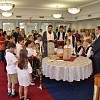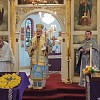Article from https://christandpopculture.com - other Friday Luke T. Harrington explores one of the many less-than-impressive moments in Christian history.
Is there anything more reassuring than a church pew?
Simple. Humble. Sturdy. Two rough-hewn planks, fastened with a handful of nails, permanently fixed to the floor—and open to all. Occasionally padded, often not; not comfortable, exactly, but comforting. An invitation to the weary traveler to sit and hear the Word of God proclaimed; a simple reminder that we follow a humble, crucified carpenter; the perfect symbol that all are equal at the foot of the cross. From the greatest king to the poorest pauper, from the holiest saint to the most desperate sinner, all have sat in these pews before us, pondering their failings and begging for mercy. Despite the advent of stadium-style seating and auditorium-like worship halls, the simple, ancient pew endures—and no wonder, because it is, and always has been, the perfect metaphor for the faith.
Seating in churches didn’t really become a thing until parishioners got bored enough to wish they were sitting down—that is, about the time of the Protestant Reformation.
Except—nothing I just said is even remotely true. In fact, it’s pretty much the exact opposite of all that. Would you like to know the true story of the pew? Okay, then—buckle up. (But not actually, though, because pews don’t have seatbelts.)
It turns out that there’s no evidence of churches having seating of any kind for at least the first 1,400 years or so of Christianity. In other words, Augustine, Athanasius, Jerome, Thomas Aquinas, Martin Luther, John Calvin—all those guys very likely lived their whole lives attending churches that were standing-room-only. During ancient Christian worship, parishioners could stand, kneel, or even mill about the nave if they so chose. There’s no record of whether they engaged in stage dives and crowd surfing, so we’re forced to assume they did.
If this sounds insanely uncomfortable to you, keep in mind that which body postures are considered comfortable or uncomfortable is a highly culturally constructed thing. The ancient Romans, for instance, almost never sat in chairs, preferring to stand or recline, while modern Japanese are still perfectly happy sitting on the floor, even well into their elder years. The idea that sitting in a backed chair is comfortable is a modern, Western notion, and one we’re currently learning has all sorts of health drawbacks. Also keep in mind that ancient and medieval Christian worship involved the average parishioner much more actively, with a lot of kneeling and recitation, and climaxed with the entire congregation coming forward for communion.
In other words, seating in churches didn’t really become a thing until parishioners got bored enough to wish they were sitting down—that is, about the time of the Protestant Reformation. In order to emphasize how not-Catholic we were, we began to jettison everything from our worship: confessions, creeds, communal prayer, a weekly Eucharist—basically everything except long, boring sermons. And when your “come to church” sales pitch is essentially “Listen to me yammer about Jesus for several hours!” the response is predictably going to be “Uh, can I at least sit down for that?”
And so, the pew was born.
When pews first began to gain in popularity, however, they weren’t anything you probably would have recognized as pews—they were more like those luxury skyboxes they have at sports stadiums. So-called “box pews,” which were particularly popular in England and America, were anything but the austere benches you’re used to, and featured four walls—often shoulder-height or higher—along with doors, windows, curtains, kneelers, tables, and sometimes even fireplaces. Basically you could hide in them and do whatever the 17th-century version of playing games on your iPad was (I’m guessing cock fights?).
They were also bought and paid for—and frequently custom-built—by each congregation’s wealthiest families, who held actual deeds to them and frequently passed them down to their children as real estate, like the world’s worst timeshares. On the rare occasion that the deed to a pew would free up, there was more often than not a public fistfight (a metaphorical one, usually) over which family would get it—being seen in a prominent pew was an important status symbol, like having the biggest beard at an Acts 29 church or having the dorkiest fedora at Hillsong.
In other words, they were pretty much the exact opposite of what Jesus says in the Gospel of Luke:
When you are invited by someone to a wedding feast, do not sit down in a place of honor, lest someone more distinguished than you be invited by him, and he who invited you both will come and say to you, “Give your place to this person,” and then you will begin with shame to take the lowest place. But when you are invited, go and sit in the lowest place, so that when your host comes he may say to you, “Friend, move up higher.” Then you will be honored in the presence of all who sit at table with you. For everyone who exalts himself will be humbled, and he who humbles himself will be exalted.
Of course, for this and numerous other reasons (see also: cramming poor congregants into a smaller and smaller space as more and more rich people demanded space for luxury pews), clergy began to speak out against them—but as is often the case, they were shouted down by economic concerns. Churches were getting more and more expensive to build and maintain, and pew sales and rentals were providing a large chunk of that funding (especially in America, where churches weren’t publicly funded). Eventually, though, the more reasonable voices won out, and most parishes did away with their box pews, replacing them with the “free and open” wooden benches we know today, resulting in worship services where uncontained toddlers run rampant, ruling over their terrified congregations with tiny iron fists.
In any case, we had finally all learned our lesson, and now nobody goes to church to be seen, which is why we all cram into the back pews and leave right after communion.
Right, guys? Or is that just me?
|
| |||||||||||||





